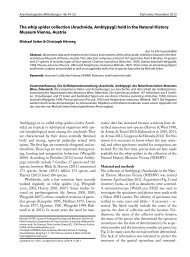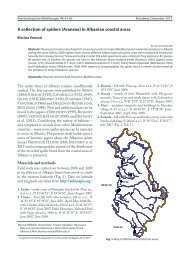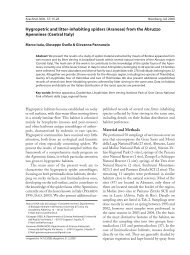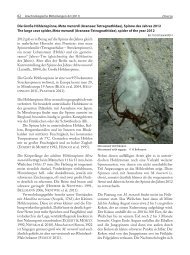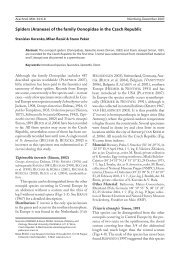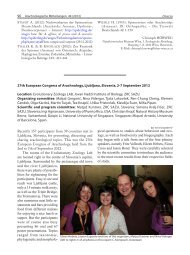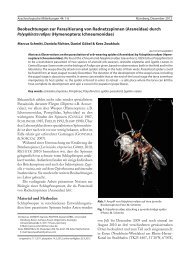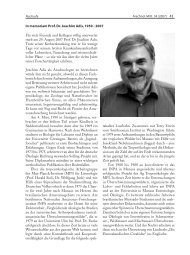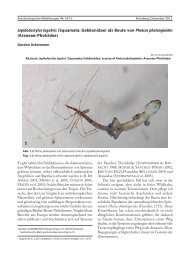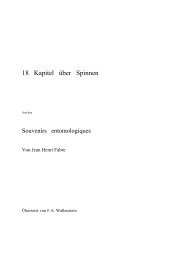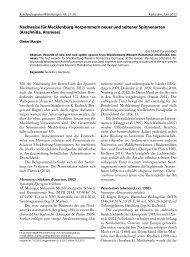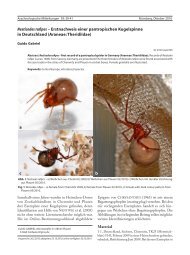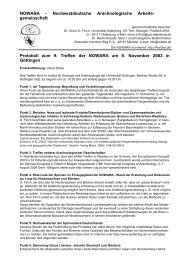download PDF - Arachnologische Gesellschaft e.V.
download PDF - Arachnologische Gesellschaft e.V.
download PDF - Arachnologische Gesellschaft e.V.
You also want an ePaper? Increase the reach of your titles
YUMPU automatically turns print PDFs into web optimized ePapers that Google loves.
<strong>Arachnologische</strong> Mitteilungen 44: 51-58 Nürnberg, Dezember 2012<br />
Faunistic spider collections in the Museum für Naturkunde Berlin: The collection<br />
of Erich Hesse<br />
Karl-Hinrich Kielhorn, Jason A. Dunlop & Corinna Steffensen<br />
doi: 10.5431/aramit4409<br />
Abstract: The ‘Hesse collection’ of spiders (Araneae) and harvestmen (Opiliones) in the Museum für Naturkunde<br />
Berlin is documented. Biographical notes on Erich Hesse – a former arachnid curator at the museum (1921–1940)<br />
– are provided. The ‘Hesse collection’ was actually put together by other workers, and can be broadly divided into<br />
two parts. One comes from Bielinek (= Bellinchen) on the Polish side of the Oder Valley (West Pommerania); now<br />
part of the ‘Unteres Odertal’ National Park. This Bielinek material includes notable records of Heriaeus oblongus Simon,<br />
1918 and Gibbaranea ullrichi (Hahn, 1835). The other part of the collection comes from Colbitz-Letzlinger Heide in<br />
Saxony-Anhalt, Germany. Notable here are Pistius truncatus (Pallas, 1772) and Philodromus buchari Kubcová, 2004; the<br />
latter representing the first record of this species for Saxony-Anhalt.<br />
Key words: Bielinek, Colbitz-Letzlinger Heide, Germany, Poland<br />
The arachnological section of the Museum für<br />
Naturkunde Berlin houses a number of, primarily<br />
regional, ‘special collections’ [Sondersammlungen]<br />
which are not integrated into the main systematic<br />
collection due to their focus on a particular set of<br />
localities and/or individuals. These may prove to be<br />
of some value for, e.g., regional faunistic studies, and<br />
as part of what we hope will be a series of papers<br />
documenting these special collections, we begin by<br />
focusing on material assembled by the former Berlin<br />
curator, Erich Hesse. These specimens were collected<br />
during the 1930s from Bielinek in western Poland<br />
and Colbitz-Letzlinger Heide in the state of Saxony-<br />
Anhalt in Germany.<br />
Material and Methods<br />
The ‘Hesse collection’ comprises ca. 200 jars, all containing<br />
material in 70 % alcohol. It is currently housed<br />
separately from the main collection. The original jars<br />
were rather small, and all specimens were recently<br />
transferred into borosilicate vials held in larger ‘twistoff<br />
’ jars as part of a wider KUR project (Program for<br />
the Conservation and Restoration of Mobile Cultural<br />
Objects). At the same time repository numbers – using<br />
our traditional acronym ZMB for ‘Zoologisches<br />
Karl-Hinrich KIELHORN, Albertstraße 10, D-10827 Berlin,<br />
Germany. E-mail: kh.kielhorn@gmx.de<br />
Jason A. DUNLOP (corresponding author), Corinna STEFFENSEN,<br />
Museum für Naturkunde, Leibniz Institute for Research on<br />
Evolution and Biodiversity at the Humboldt University Berlin,<br />
Invalidenstraße 43, D-10115 Berlin, Germany. E-mail: jason.<br />
dunlop@mfn-berlin.de, corinna_steffensen@hotmail.de<br />
eingereicht: 14.9.2012, akzeptiert: 15.11.2012; online verfügbar: 28.12.2012<br />
Fig. 1: Portrait of Erich Hesse (1874–1945?), arachnid<br />
curator in Berlin from 1921–1940. Image courtesy of<br />
the Museum für Naturkunde Berlin, Historische Bild- u.<br />
Schriftgutsammlungen (Sigel: MfN, HBSB). Bestand: Zool.<br />
Mus. Signatur: B I/1069.<br />
Museum Berlin’ – were formally assigned. Identities of<br />
individual specimens were, where necessary, checked<br />
by KHK and the jars were re-labelled accordingly.<br />
Only taxa which could be placed with confidence at<br />
species level are included in the results (Tab. 1 and<br />
2). Additional lots are present in the collection, but<br />
consist of juveniles and/or specimens in poor condi-
52 K.-H. Kielhorn, J. A. Dunlop & C. Steffensen<br />
tion which cannot be placed beyond the family or<br />
genus (see also below). Species names are derived from<br />
the latest version of the Platnick Catalog (Platnick<br />
2012) and the updated nomenclature was adopted for<br />
the new labels. The sequence of taxa used in Tab. 1<br />
and 2 also follows Platnick (2012).<br />
Erich Hesse<br />
Following Gebhardt (1972) and hackethal<br />
(1985), Erich Hesse (Fig. 1) was born in Leipzig in<br />
1874, where he also studied, receiving his doctorate in<br />
1899. From 1909–1911 he held an assistant position at<br />
the Imperial Biological Institute for Agriculture and<br />
Forestry [Kaiserliche Biologische Anstalt für Land-<br />
und Forstwirtschaft] in Berlin-Dahlem. In 1911<br />
he became a scientific assistant [‘wissenschaftlicher<br />
Hilfsarbeiter’] in the ornithology collection of the<br />
Museum für Naturkunde Berlin (MfN) – then under<br />
its older name Zoologisches Museum Berlin – where<br />
he worked under Anton Reichenow (1847–1941).<br />
From 1916–1918 Hesse returned to Leipzig as<br />
curator of zoology at the university museum, before<br />
coming back to Berlin in October 1918 as curator,<br />
first of the exhibition material [Schausammlung],<br />
and subsequently from April 1921 the arachnid<br />
collection (PaPPenheim 1928). Here, he evidently<br />
replaced Friedrich Dahl as curator. Hesse remained<br />
in the museum until his own retirement in 1940, but<br />
does not seem to have been formally replaced as curator<br />
during the war years; the next incumbent being<br />
Alfred Kästner from 1946 onwards. Hesse’s tenure as<br />
curator is poorly documented and his eventual fate is<br />
unknown; he is simply listed as ‘missing’ as of spring<br />
1945. No correspondence from his time as curator<br />
survives and – perhaps for political reasons following<br />
the war – even the relevant page of the original loan<br />
book was at some stage physically cut out; such that<br />
the recorded loans jump from Dahl’s last entry in 1921<br />
to Kästner’s first in 1948.<br />
Although holding the arachnid curatorship for<br />
nearly 20 years, Hesse was essentially an ornithologist.<br />
Gebhardt (1972) cites him as an expert on<br />
birds from the lakes and moorlands around Berlin<br />
and in 1916, together with Reichenow, he produced<br />
a complete list of the birds of Germany (hesse &<br />
reichenow 1916). Other papers in this field include<br />
hesse (1907, 1913, 1915). As late as 1933 he<br />
was still doing ornithological work, producing a new<br />
version of A. Voigt’s ‘Exkursionsbuch zum Studium<br />
der Vogelstimmen’ [Excursion book for the study of<br />
birdsong]. It is not entirely clear why he was appointed<br />
to the arachnid curatorship and/or why a recognised<br />
arachnologist was not appointed as Dahl’s successor.<br />
The impression from PaPPenheim (1928: 4-5) is of a<br />
major staff turnover in the museum around 1921, involving<br />
numerous retirements and new appointments.<br />
According to Gebhardt (1972), Hesse had hoped<br />
to receive the ornithology curatorship on Reichenow’s<br />
retirement [also in 1921], but instead this post went<br />
to Erwin Stresemann (1889–1972) who went on to<br />
become one of the most highly regarded ornithologists<br />
in Germany.<br />
Despite these circumstances, Hesse was appointed<br />
professor in April 1924 (cf. PaPPenheim<br />
1928) and as well as continuing to publish on birds<br />
he also began working on other groups such as flies,<br />
molluscs, amphibians and mammals; typically with<br />
a focus on the local Brandenburg fauna. Eventually<br />
Hesse also produced a handful of faunistic papers on<br />
spiders (hesse 1935, 1936, 1937, 1939a, 1939b, 1940,<br />
1941). These concentrated primarily on two localities:<br />
Bellinchen (= Bielinek, West Pommerania, Poland)<br />
in the Oder valley and Colbitz-Letzlinger Heide in<br />
Saxony-Anhalt, Germany; although it is clear from<br />
the literature that he did not actually collect the material<br />
himself (see below). During the time of Hesse’s<br />
curatorship, PaPPenheim (1928, p. 22) recorded a<br />
major reordering of the arachnid collection as having<br />
taken place in the 1920s. This may have been associated<br />
with the spider collection moving into a new<br />
extension of the museum building which was built<br />
between 1914 and 1917.<br />
The spider Ishania hessei (Chamberlin & Ivie,<br />
1936) (Araneae: Zodariidae), the camel spiders<br />
Ceroma hessei Roewer, 1933 (Solifugae: Ceromidae)<br />
and Eremobates hessei (Roewer, 1934) (Solifugae:<br />
Eremobatidae), and the polydesmid millipede Polydesmus<br />
hessei Verhoeff, 1931 (Diplopoda: Polydesmida:<br />
Polydesmidae) were all named after Erich Hesse.<br />
Results and Discussion<br />
Bielinek (= Bellinchen)<br />
Bielinek – formally known under the German name<br />
Bellinchen – lies on the Polish side of the river Oder<br />
in Western Pomerania (52.9302 N, 14.16001 E, 71<br />
m asl). It has long been used as a study area by biologists<br />
and treated as an area of nature protection. It is<br />
currently part of the German/Polish ‘Nationalpark<br />
Unteres Odertal’ .<br />
Note that it is important not to confuse<br />
Bellinchen/Bielinek, which is directly on the river<br />
Oder, with the similar sounding Berlinchen/Barlinek
Erich Hesse collection in Berlin 53<br />
which is also in West Pomerania, but further to the<br />
east. The Bielinek arachnid material in the Berlin<br />
museum was collected in at least three phases by H.<br />
Engel (1935) (hesse 1936), numerous collectors<br />
(hesse 1937) and by G. Frenzel and H. Hedicke<br />
(1937–38). Standard collecting methods such as<br />
sweep nets, beating, hand collection, etc. were used.<br />
The original collecting area comprised various habitats,<br />
including clay pits, wooded areas, wetlands, and<br />
most importantly, dry sloping grasslands with pontic<br />
steppe vegetation. The material was formally studied<br />
by hesse (1939a).<br />
Our present re-investigation of the ZMB material<br />
from both Bielinek and Colbitz-Letzlinger Heide<br />
revealed two problems. First, Hesse attempted to<br />
identify even very young juveniles to species level.<br />
His proposed names for these immature specimens<br />
have largely had to be rejected here, since we could<br />
not confirm the species identity of these vouchers.<br />
Second, the poor condition of some individual specimens<br />
prevented us from confirming their proposed<br />
identification. Taking these limitations into account,<br />
92 spider species, plus four harvestmen, dating from<br />
the 1930s could unequivocally be documented from<br />
Bielinek in the Hesse collection (Tab. 1). By comparison,<br />
Hesse (1939) recognised 138 spider species<br />
and six harvestmen. It should be noted that this fairly<br />
large discrepancy includes material now apparently<br />
missing from the collection.<br />
Of particular note are two spider records – Heriaeus<br />
oblongus Simon, 1918 and Gibbaranea ullrichi<br />
(Hahn, 1835) – both of which are very rare for Central<br />
Europe. Both species prefer open, warm–dry habitats,<br />
such as those which were previously quite widespread<br />
(cf. ZumPt 1931) in the ‘Steppenheide’ near the river<br />
Oder at Bielinek. Staręga et al. (2002) placed H.<br />
oblongus in the category ’endangered’ for the Red List<br />
of Poland’s spiders. Twenty-eight individuals of this<br />
species were caught at Bielinek between 1936 and<br />
1938.<br />
Colbitz-Letzlinger Heide<br />
The second part of the Hesse collection comes<br />
from the ‘Waldstation’ at Colbitz-Letzlinger Heide<br />
(52.35011 N, 11.61072 E, 96 m asl). It was collected<br />
in 1936/37, again by H. Engel. This field station<br />
near Magdeburg in the modern state of Saxony-<br />
Anhalt belonged to the Department of Forestry<br />
Protection of the Prussian Experimental Institute for<br />
Forestry in Eberswalde [Außenstelle der Abteilung<br />
für Waldschutz der Preußischen Versuchsanstalt für<br />
Waldwirtschaft Eberswalde]. The biotope includes<br />
pine forest and mixed stands of pine and oak. The<br />
focus of the study was spiders (and other animals)<br />
from the tree crowns (enGel 1941). The collection<br />
method used was to fell a series of conifers and remove<br />
their branches over a large sheet. Specimens were then<br />
collected by hand or from subsequent laboratory study<br />
of the remaining branches. A preliminary account of<br />
this work was published by hesse (1939b), with a<br />
more detailed report by hesse (1940). Even taking<br />
into account changes in nomenclature, it should be<br />
noted that the published data does not match exactly<br />
what is in the collection. For example, hesse (1939b)<br />
discussed a record of Araneus saevus L. Koch, 1872<br />
[as A. zimmermanni], but this species could not be<br />
found as voucher specimen(s) within either the Hesse<br />
collection, or misplaced within the main systematic<br />
collection.<br />
Cataloguing and re-identification of the specimens<br />
actually present in the Berlin museum yielded<br />
unequivocal records of 67 species of spider, plus one<br />
harvestman, collected in the 1930s at Colbitz-Letzlinger<br />
Heide (Tab. 2). By comparison, hesse (1940)<br />
recognised 89 spider species and two harvestmen.<br />
As expected from the study method used, the faunal<br />
records are primarily of arboricolous species – including<br />
a couple of rarities. For example, the crab spider<br />
Pistius truncatus (Pallas, 1772) was first recorded again<br />
from Saxony-Anhalt over 70 years later (kielhorn<br />
2011). Among the specimens originally labelled as<br />
Philodromus aureolus (Clerck, 1757) two females could<br />
be re-identified here as P. buchari Kubcová, 2004. This<br />
is the only record so far of this running crab spider<br />
species from the state of Saxony-Anhalt.<br />
Conclusions<br />
Our review of the Hesse collection raises a couple of<br />
interesting points. On the one hand it demonstrates<br />
that it is sometimes necessary to reconfirm published<br />
faunistic data; particularly in cases where the author<br />
was not a recognised specialist for the relevant group.<br />
Hesse’s identifications based on juveniles here are a<br />
case in point. Perhaps more important is the fact that<br />
museums can – and do – act as repositories for voucher<br />
specimens deriving from historical ecological studies,<br />
and that the original material is still available for (re)<br />
study. The data can be checked and compared directly<br />
with modern faunistic studies in these geographical<br />
regions, offering here a historical perspective on faunal<br />
compositions dating back more than seventy years.<br />
In the specific case of Colblitz-Letzlinger Heide we
54 K.-H. Kielhorn, J. A. Dunlop & C. Steffensen<br />
have data from a (then) highly innovative method of<br />
collecting animals from tree crowns. Arboricolous spiders<br />
are less accessible than those living closer to the<br />
Tab. 1: Species list from the Bielinek (= Bellinchen) part of the Hesse collection<br />
ground which can be collected by sweeping or pitfalls<br />
and have, in recent years, become a particular focus of<br />
faunistic studies (e.g. Gossner 2004, blick 2011).<br />
Taxa Repository number<br />
Araneae<br />
Mimetidae (2)<br />
Ero aphana (Walckenaer, 1802) ZMB 32663<br />
Ero furcata (Villers, 1789) ZMB 32664<br />
Eresidae (1)<br />
Eresus kollari Rossi, 1846 ZMB 32536<br />
Theridiidae (7)<br />
Dipoena braccata (C. L. Koch, 1841) ZMB 32659<br />
Enoplognatha latimana Hippa & Oksala, 1982 ZMB 48500<br />
Enoplognatha ovata (Clerck, 1757) ZMB 32657<br />
Episinus angulatus (Blackwall, 1836) ZMB 32658<br />
Neottiura bimaculata (Linnaeus, 1767) ZMB 32660<br />
Phylloneta impressa (L. Koch, 1881) ZMB 32661<br />
Theridion varians Hahn, 1833 ZMB 32662<br />
Linyphiidae (11)<br />
Anguliphantes angulipalpis (Westring, 1851) ZMB 34708<br />
Bathyphantes nigrinus (Westring, 1851) ZMB 34707<br />
Diplocephalus picinus (Blackwall, 1841) ZMB 34679<br />
Dismodicus elevatus (C.L. Koch, 1838) ZMB 34678<br />
Erigone atra Blackwall, 1833 ZMB 34677<br />
Gongylidium rufipes (Linnaeus, 1758) ZMB 34680–34683<br />
Linyphia hortensis Sundevall, 1830 ZMB 34684–34691<br />
Linyphia triangularis (Clerck, 1757) ZMB 34693–34706<br />
Microlinyphia pusilla (Sundevall, 1830) ZMB 34692, 34710<br />
Microneta viaria (Blackwall, 1841) ZMB 34676<br />
Tenuiphantes flavipes (Blackwall, 1854) ZMB 34709<br />
Tetragnathidae (6)<br />
Pachygnatha clercki Sundevall, 1823 ZMB 34722<br />
Pachygnatha listeri Sundevall, 1830 ZMB 34723–34725<br />
Metellina mengei (Blackwall, 1870) ZMB 34712, 34713, 34715, 34717–34721<br />
Tetragnatha extensa (Linnaeus, 1758) ZMB 34726, 34729<br />
Tetragnatha montana Simon, 1874 ZMB 34731–34749<br />
Tetragnatha nigrita Lendl, 1886 ZMB 34730<br />
Araneidae (16)<br />
Agalenatea redii (Scopoli, 1763) ZMB 34790<br />
Araneus alsine (Walckenaer, 1802) ZMB 34753<br />
Araneus angulatus Clerck, 1757 ZMB 34754<br />
Araneus diadematus Clerck, 1757 ZMB 34755–34758<br />
Araneus quadratus Clerck, 1757 ZMB 34760–34763<br />
Araneus sturmi (Hahn, 1831) ZMB 34791<br />
Argiope bruennichi (Scopoli, 1772) ZMB 34779–34783<br />
Araniella cucurbitina (Clerck, 1757) ZMB 34768, 34770–34774, 34776, 34777<br />
Cyclosa oculata (Walckenaer, 1802) ZMB 34792<br />
Gibbaranea bituberculata (Walckenaer, 1802) ZMB 34784–34788<br />
Gibbaranea ullrichi (Hahn, 1835) ZMB 34789<br />
Larinioides ixobolus (Thorell, 1873) ZMB 34793<br />
Larinioides sclopetarius (Clerck, 1757) ZMB 34765–34767<br />
Mangora acalypha (Walckenaer, 1802) ZMB 34796–34804
Erich Hesse collection in Berlin 55<br />
Taxa Repository number<br />
Neoscona adianta (Walckenaer, 1802) ZMB 34805–34807<br />
Singa nitidula C. L. Koch, 1844 ZMB 34794<br />
Lycosidae (6)<br />
Arctosa cinerea (Fabricius, 1777) ZMB 34810<br />
Alopecosa cuneata (Clerck, 1757) ZMB 34809<br />
Piratula hygrophila (Thorell, 1872) ZMB 34826–34829<br />
Pardosa saltans Töpfer-Hofmann, 2000 ZMB 34811, 34825<br />
Trochosa ruricola (De Geer, 1778) ZMB 48501<br />
Trochosa terricola Thorell, 1856 ZMB 34814<br />
Agelenidae (2)<br />
Agelena labyrinthica (Clerck, 1757) ZMB 34823<br />
Tegenaria atrica C.L. Koch, 1843 ZMB 34830–34831<br />
Cybaeidae (1)<br />
Argyroneta aquatica (Clerck, 1757) ZMB 34750–34751<br />
Hahniidae (1)<br />
Antistea elegans (Blackwall, 1841) ZMB 34834<br />
Dictynidae<br />
Dictyna arundinacea (Linnaeus, 1758) ZMB 34835–34837<br />
Miturgidae (1)<br />
Cheiracanthium oncognathum Thorell, 1871 ZMB 32665<br />
Anyphaenidae (1)<br />
Anyphaena accentuata (Walckenaer, 1802) ZMB 34838–34842<br />
Liocranidae (1)<br />
Scotina celans (Blackwall, 1841) ZMB 34843<br />
Clubionidae (3)<br />
Clubiona pallidula (Clerck, 1757) ZMB 32668<br />
Clubiona neglecta O.P.-Cambridge, 1862 ZMB 32666<br />
Clubiona terrestris Westring, 1851 ZMB 32669<br />
Gnaphosidae (6)<br />
Drassodes lapidosus (Walckenaer, 1802) ZMB 34845<br />
Gnaphosa lugubris (C.L. Koch, 1839) ZMB 34847<br />
Haplodrassus silvestris (Blackwall, 1833) ZMB 34846<br />
Trachyzelotes pedestris (C.L. Koch, 1837) ZMB 34848<br />
Zelotes longipes (L. Koch, 1866) ZMB 34850<br />
Zelotes subterraneus (C.L. Koch, 1833) ZMB 34849<br />
Philodromidae (6)<br />
Philodromus cespitum (Walckenaer, 1802) ZMB 34854, 34856–34858<br />
Philodromus collinus C.L. Koch, 1835 ZMB 34851<br />
Philodromus dispar Walckenaer, 1826 ZMB 34860–34867<br />
Philodromus emarginatus (Schrank, 1803) ZMB 34859<br />
Tibellus oblongus (Walckenaer, 1802) ZMB 34870–34877, 34879–34881, 34883–34885<br />
Thanatus arenarius L. Koch, 1872 ZMB 34868–34869<br />
Thomisidae (5)<br />
Diaea dorsata (Fabricius, 1777) ZMB 34887<br />
Heriaeus oblongus Simon, 1918 ZMB 34890<br />
Misumena vatia (Clerck, 1757) ZMB 34891–34897<br />
Pistius truncatus (Pallas, 1772) ZMB 34888<br />
Synema globosum (Fabricius, 1775) ZMB 34889<br />
Salticidae (15)<br />
Asianellus festivus (C.L. Koch, 1834) ZMB 34929–34932<br />
Ballus chalybeius (Walckenaer, 1802) ZMB 34898–34899<br />
Evarcha arcuata (Clerck, 1757) ZMB 34905<br />
Evarcha falcata (Clerck, 1757) ZMB 34900–34904, 34906–349012, 34914<br />
Evarcha laetabunda (C.L. Koch, 1846) ZMB 34918<br />
Heliophanus auratus C.L. Koch, 1835 ZMB 34915, 34927, 34928
56 K.-H. Kielhorn, J. A. Dunlop & C. Steffensen<br />
Taxa Repository number<br />
Heliophanus cupreus (Walckenaer, 1802) ZMB 34916, 34924<br />
Heliophanus flavipes (Hahn, 1832) ZMB 34925, 34926<br />
Marpissa muscosa (Clerck, 1757) ZMB 34919<br />
Marpisa radiata (Grube, 1859) ZMB 34920<br />
Myrmarachne formicaria (De Geer, 1778) ZMB 34921<br />
Salticus cingulatus (Panzer, 1797) ZMB 34913<br />
Salticus scenicus (Clerck, 1757) ZMB 34933–34935<br />
Synageles hilarulus (C.L. Koch, 1846) ZMB 34939–34941<br />
Yllenus arenarius Menge, 1868 ZMB 34923<br />
Opiliones<br />
Phalangiidae (2)<br />
Lacinius horridus (Panzer, 1794) ZMB 34947<br />
Rilaena triangularis (Herbst, 1799) ZMB 34942–39446<br />
Sclerosomatidae (2)<br />
Leiobunum blackwalli Meade 1861 ZMB 34948<br />
Leiobunum rotundum (Latreille, 1798) ZMB 34949<br />
Tab. 2: Species list from the Colbitz-Letzlinger Heide part of the Hesse collection<br />
Taxa Repository number<br />
Araneae<br />
Segestriidae (1)<br />
Segestria senoculata (Linneaus, 1758) ZMB 32576<br />
Dysderidae (1)<br />
Harpactea hombergi (Scopoli, 1763) ZMB 32577<br />
Uloboridae (1)<br />
Hyptiotes paradoxus (C.L. Koch, 1834) ZMB 32578<br />
Theridiidae (8)<br />
Anelosimus vittatus (C.L. Koch, 1836) ZMB 32585<br />
Dipoena melanogaster (C.L. Koch, 1837) ZMB 32584<br />
Enoplognatha ovata (Clerck, 1757) ZMB 32583<br />
Paidiscura pallens (Blackwall, 1834) ZMB 32582<br />
Parasteatoda lunata (Clerck, 1757) ZMB 32586<br />
Platnickina tincta (Walckenaer, 1802) ZMB 32580<br />
Theridion pinastri L. Koch, 1872 ZMB 32581<br />
Theridion varians Hahn, 1833 ZMB 32579<br />
Linyphiidae (10)<br />
Abacoproeces saltuum (L. Koch, 1872) ZMB 32587<br />
Dismodicus bifrons (Blackwall, 1841) ZMB 32588<br />
Drapetisca socialis (Sundevall, 1833) ZMB 32589<br />
Entelecara congenera (O. P.-Cambridge, 1879) ZMB 32590<br />
Erigone atra Blackwall, 1833 ZMB 32591<br />
Erigone dentipalpis (Wider, 1834) ZMB 32592<br />
Gonatium rubens (Blackwall, 1833) ZMB 32594<br />
Hypomma bituberculatum (Wider, 1834) ZMB 32593<br />
Linyphia triangularis (Clerck, 1757) ZMB 32595<br />
Moebelia penicillata (Westring, 1851) ZMB 48502<br />
Tetragnathidae (4)<br />
Metellina mengei (Blackwall, 1870) ZMB 48504<br />
Metellina segmentata (Clerck, 1757) ZMB 32596<br />
Tetragnatha obtusa (C.L. Koch, 1837) ZMB 32598, 32599<br />
Tetragnatha pinicola (L. Koch, 1870) ZMB 32600<br />
Araneidae (11)<br />
Araneus alsine (Walckenaer, 1802) ZMB 32601<br />
Araneus diadematus Clerck, 1757 ZMB 32602
Erich Hesse collection in Berlin 57<br />
Taxa Repository number<br />
Araneus quadratus Clerck, 1757 ZMB 32603<br />
Araneus sturmi (Hahn, 1831) ZMB 32604<br />
Araniella curcurbitina (Clerck, 1757) ZMB 32606<br />
Cercidia prominens (Westring, 1851) ZMB 32608<br />
Cyclosa conica (Pallas, 1772) ZMB 32609<br />
Gibbaranea gibbosa (Walckenaer, 1802) ZMB 32610<br />
Mangora acalypha (Walckenaer, 1802) ZMB 32611<br />
Neoscona adianta (Walckenaer, 1802) ZMB 32612<br />
Zilla diodia (Walckenaer, 1802) ZMB 32613<br />
Pisauridae (1)<br />
Pisaura mirabilis (Clerck, 1757) ZMB 32616<br />
Zoridae (1)<br />
Zora spinimana (Sundevall, 1833) ZMB 32633, 32634<br />
Agelenidae (1)<br />
Agelena labyrinthica (Clerck, 1757) ZMB 32617<br />
Dictynidae (2)<br />
Dictyna pusilla Thorell, 1856 ZMB 32619, 32620<br />
Nigma flavescens (Walckenaer, 1830) ZMB 32621<br />
Anyphaenidae (1)<br />
Anyphaena accentuata (Walckenaer, 1802) ZMB 32622<br />
Liocranidae (1)<br />
Agroeca brunnea (Blackwall, 1833) ZMB 32623<br />
Clubionidae (5)<br />
Clubiona brevipes Blackwall, 1841 ZMB 32624<br />
Clubiona caerulescens L. Koch, 1867 ZMB 32625<br />
Clubiona comta C.L. Koch, 1839 ZMB 32626<br />
Clubiona subsultans Thorell, 1875 ZMB 32628<br />
Clubiona terrestris Westring, 1851 ZMB 32629<br />
Gnaphosidae (3)<br />
Haplodrassus cognatus (Westring, 1861) ZMB 32630<br />
Micaria pulicaria (Sundevall, 1831) ZMB 32631<br />
Zelotes clivicola (L. Koch, 1870) ZMB 32632<br />
Philodromidae (4)<br />
Philodromus aureolus (Clerck, 1757) ZMB 32635<br />
Philodromus buchari Kubcová, 2004 ZMB 48503<br />
Philodromus collinus C.L. Koch, 1835 ZMB 32636<br />
Philodromus margaritatus (Clerck, 1757) ZMB 32638<br />
Thomisidae (4)<br />
Coriarachne depressa (C.L. Koch, 1837) ZMB 32639<br />
Diaea dorsata (Fabricius, 1777) ZMB 32640<br />
Pistius truncatus (Pallas, 1772) ZMB 32641<br />
Synema globosum (Fabricius, 1775) ZMB 32642<br />
Salticidae (8)<br />
Ballus chalybeius (Walckenaer, 1802) ZMB 32645<br />
Dendryphantes rudis (Sundevall, 1833 ZMB 32646, 32647<br />
Euophrys frontalis (Walckenaer, 1802) ZMB 32651<br />
Evarcha falcata (Clerck, 1757) ZMB 32648, 32649<br />
Heliophanus dubius C.L. Koch, 1835 ZMB 32652<br />
Marpissa muscosa (Clerck, 1757) ZMB 32653<br />
Pseudeuophrys erratica (Walckenaer, 1826) ZMB 32650<br />
Salticus zebraneus (C.L. Koch, 1837) ZMB 32654<br />
Opiliones<br />
Phalangiidae (1)<br />
Lacinius horridus (Panzer, 1794) ZMB 32643
58 K.-H. Kielhorn, J. A. Dunlop & C. Steffensen<br />
Acknowledgments<br />
We thank Birger Neuhaus (MfN) as coordinator of the<br />
KUR project and Denise Jekel and Benjamin Nitzsche for<br />
their work transferring specimens as part of this initiative.<br />
Anja Friederichs (MfN) offered curatorial assistance,<br />
Sabine Hackethal (MfN) provided the portrait of Erich<br />
Hesse and Christoph Muster (Puttbus) kindly checked<br />
the identification of Philodromus buchari. We also thank<br />
the reviewers, Ambros Hänggi and Elisabeth Bauchhenß,<br />
for valuable remarks.<br />
References<br />
blick t. (2011): Abundant and rare spiders on tree trunks<br />
in German forests (Arachnida, Araneae). – <strong>Arachnologische</strong><br />
Mitteilungen 40: 5-14 – doi: 10.5431/aramit4002<br />
enGel h. (1941): Beiträge zur Faunistik der Kiefernkronen<br />
in verschiedenen Bestandstypen. – Mitteilungen<br />
aus Forstwirtschaft und Forstwissenschaft 4: 334-361<br />
Gebhardt L. (1972): „Hesse, Erich“. In: Neue Deutsche<br />
Biographie 9 (1972). S. 16 f. [Onlinefassung]. – Internet:<br />
http://www.deutsche-biographie.de/pnd117523860.<br />
html [accessed Oct. 2012]<br />
Gossner M. (2004): Diversität und Struktur arborikoler<br />
Arthropodenzönosen fremdländischer und einheimischer<br />
Baumarten. Ein Beitrag zur Bewertung des Anbaus<br />
von Douglasie (Pseudotsuga menziesii (Mirb.) Franco)<br />
und Roteiche (Quercus rubra L.). – Neobiota 5: 1-324<br />
hackethal S. (1985): Kurzbiographien und Porträts<br />
Berliner Zoologen. – Wissenschaftliche Zeitschrift<br />
der Humboldt-Universität zu Berlin, Mathematisch-<br />
Naturwissenschaftliche Reihe 34: 385-406<br />
hesse E. (1907): Über den inneren knöchernen Bau des<br />
Vogelschnabels. – Journal für Ornithologie 55: 185-248<br />
– doi: 10.1007/BF02089327<br />
hesse E. (1913): Übersicht einer Vogelsammlung aus dem<br />
Altai. Ein Beitrag zur Ornis Innerasiens. – Mitteilungen<br />
aus dem Zoologischen Museum in Berlin 6: 351-434<br />
hesse E. (1915): Bernhard Hantzschs ornithologische<br />
Ausbeute in Baffinland. – Journal für Ornithologie 63:<br />
137-228 – doi: 10.1007/BF02094437<br />
hesse e. (1935): Beiträge zur Arachnoidenfauna der<br />
Mark. – Märkische Tierwelt 1: 182-193<br />
hesse e. (1936): Die Fauna der Binnendüne bei Bellinchen<br />
(Oder). IV. Die Tierwelt – Arachnoidea. – Märkische<br />
Tierwelt 2: 134-140<br />
hesse E. (1937): Die Arachnoidenfauna des Naturschutzgebietes<br />
Bellinchen (Oder). – Märkische Tierwelt 3:<br />
99-107<br />
hesse e. (1939a): Die Arachnoidenfauna des Naturschutzgebietes<br />
Bellinchen (Oder). 2. Beitrag. – Märkische<br />
Tierwelt 4: 105-118<br />
hesse E. (1939b): Zwei ökologisch-faunistische Beiträge.<br />
– Zoologischer Anzeiger 127: 270-272<br />
hesse E. (1940): Untersuchungen an einer Kollektion<br />
Wipfelspinnen. – Sitzungsberichte der <strong>Gesellschaft</strong><br />
naturforschender Freunde zu Berlin 1940: 350-363<br />
hesse e. (1941): Kleine Beiträge zur Fauna der Mark. –<br />
Märkische Tierwelt 4: 289-296<br />
hesse e. & a. reichenow (1916): Neue Namenliste<br />
der Vögel Deutschlands. – Journal für Ornithologie 64:<br />
325-371 – doi: 10.1007/BF02250485<br />
kielhorn K.-H. (2011): Bemerkenswerte Spinnenfunde<br />
aus Sachsen-Anhalt (Arachnida: Araneae). – Entomologische<br />
Zeitschrift 121: 231-237<br />
PaPPenheim P. (1928): Bericht über das Zoologische<br />
Museum der Universität Berlin in den Jahren 1916–1926<br />
(t. IV.1916 – 31.III.1927). Verlag des Museums, Berlin.<br />
62 pp.<br />
Platnick N.I. (2012): The world spider catalog, version<br />
13.0. American Museum of Natural History. – Internet:<br />
http://research.amnh.org/iz/spiders/catalog<br />
Staręga W., C. BłaSzak & J. rafalski (2002): arachnida<br />
pajęczaki. In: głoWaCIńSkI z. (ed.): Czerwona<br />
lista zwierząt ginących i zagrożonych w Polsce. Instytut<br />
Ochrony Przyrody PAN, Kraków. pp. 133-140<br />
ZumPt F. (1931): Die Koleopterenfauna des Steppenheidebiotops<br />
von Bellinchen und Oderberg (Fauna marchica).<br />
– Beiträge zur Naturdenkmalpflege 14: 363-449



